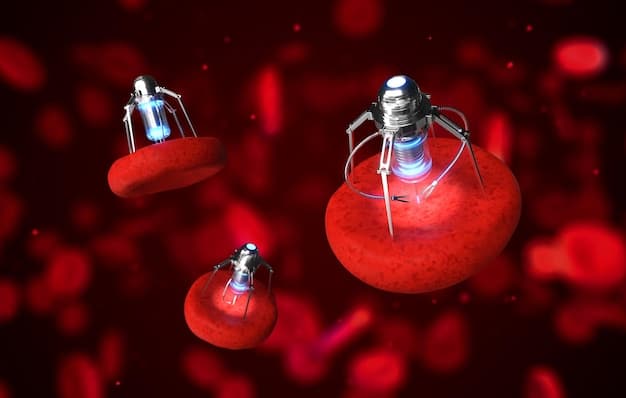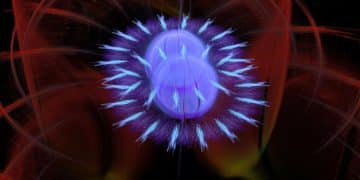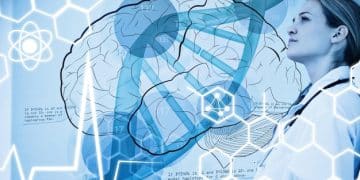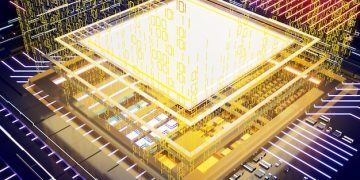Emerging Nanotechnology Trends and Applications in the US

Emerging trends in nanotechnology in the US include advancements in nanoelectronics, nanomedicine, nanomaterials, and nanotoxicology, leading to applications in healthcare, energy, and manufacturing.
The field of nanotechnology is rapidly evolving, promising groundbreaking advancements across various industries. In the United States, cutting-edge research and development are driving innovation at the nanoscale. Understanding what are the emerging trends in nanotechnology and their applications in the US is crucial for businesses, researchers, and anyone interested in the future of technology.
Understanding Nanotechnology and Its Scope
Nanotechnology involves the manipulation of matter at the atomic and molecular level, typically between 1 and 100 nanometers. This field encompasses a wide range of scientific disciplines, including chemistry, physics, biology, materials science, and engineering. In the US, significant investments in nanotechnology research are fostering innovations with the potential to transform multiple sectors.
The scope of nanotechnology extends to creating new materials, devices, and systems with unique properties and functionalities. These advancements are not just incremental improvements; they often represent disruptive technologies that can reshape entire industries. From enhancing drug delivery systems to developing stronger and lighter materials, nanotechnology is poised to address some of the most pressing challenges facing society today.
Key Disciplines in Nanotechnology
Several key disciplines drive the progress of nanotechnology, each contributing unique perspectives and capabilities. These include:
- Nanoelectronics: Focuses on developing electronic components and devices at the nanoscale, enabling faster and more energy-efficient computing systems.
- Nanomaterials: Involves the creation and manipulation of materials with nanoscale dimensions, leading to enhanced mechanical, electrical, and thermal properties.
- Nanobiotechnology: Integrates nanotechnology with biological systems, offering new tools for diagnostics, drug delivery, and regenerative medicine.
- Nanophotonics: Explores the interaction of light with nanoscale structures, paving the way for advanced optical devices and sensors.
These disciplines are interconnected, with breakthroughs in one area often influencing developments in others. This collaborative approach is essential for realizing the full potential of nanotechnology in the US.
In summary, nanotechnology is a multidisciplinary field that holds immense promise for transforming numerous industries in the US. By understanding its scope and key disciplines, stakeholders can better appreciate the emerging trends and their potential impact.
Advancements in Nanoelectronics
Nanoelectronics focuses on creating electronic devices and circuits at the nanoscale. This field aims to overcome the limitations of traditional microelectronics by leveraging the unique properties of nanomaterials. In the US, research in nanoelectronics is driving the development of faster, more energy-efficient, and smaller electronic components.
The potential applications of nanoelectronics are vast, ranging from advanced computing systems to high-resolution displays. By reducing the size of electronic components, nanoelectronics can significantly improve the performance and capabilities of electronic devices.

Quantum Computing and Nanoelectronics
Quantum computing is an emerging field that could benefit significantly from advancements in nanoelectronics. The ability to fabricate and control quantum bits (qubits) at the nanoscale is essential for building practical quantum computers. Nanoelectronics provides the tools and techniques necessary to achieve this level of control.
Quantum dots, nanowires, and other nanoscale structures are being explored as potential building blocks for qubits. These components can exhibit quantum mechanical phenomena, such as superposition and entanglement, which are fundamental to quantum computing.
Challenges and Opportunities
Despite the promise of nanoelectronics, significant challenges remain. These include:
- Fabrication Complexity: Manufacturing electronic devices at the nanoscale requires extremely precise and controlled processes.
- Reliability: Ensuring the long-term reliability of nanoscale components is crucial for practical applications.
- Integration: Integrating nanoscale devices into existing electronic systems can be challenging.
Overcoming these challenges will require continued innovation in materials science, fabrication techniques, and device design. The US is investing heavily in research and development to address these issues and unlock the full potential of nanoelectronics.
Nanoelectronics is a critical area of nanotechnology with the potential to revolutionize the electronics industry. By advancing our understanding and capabilities in this field, the US can maintain its leadership in technology innovation.
Nanomaterials: Properties and Applications
Nanomaterials are materials with at least one dimension between 1 and 100 nanometers. These materials often exhibit unique physical, chemical, and biological properties that are not observed in their bulk counterparts. In the US, nanomaterials are being developed for a wide range of applications, including energy storage, biomedical devices, and environmental remediation.
The special properties of nanomaterials arise from their high surface area-to-volume ratio and quantum mechanical effects. These characteristics allow nanomaterials to interact more effectively with their environment and exhibit enhanced performance in various applications.
Types of Nanomaterials
Several types of nanomaterials are being actively researched and developed in the US, including:
- Nanoparticles: Tiny particles with diameters ranging from 1 to 100 nanometers, used in drug delivery, cosmetics, and catalysts.
- Nanotubes: Cylindrical structures made of carbon or other materials, known for their high strength and electrical conductivity.
- Nanosheets: Two-dimensional materials with a thickness of only a few nanometers, used in electronics, sensors, and composites.
- Quantum Dots: Semiconductor nanocrystals that exhibit quantum mechanical properties, used in displays, solar cells, and bioimaging.
Each type of nanomaterial offers unique advantages for specific applications. Researchers are continually exploring new ways to synthesize, modify, and apply these materials to solve real-world problems.
Applications in Various Industries
Nanomaterials are finding increasing use in various industries across the US, including:
- Healthcare: Nanoparticles are used for targeted drug delivery, medical imaging, and diagnostics.
- Energy: Nanomaterials enhance the performance of batteries, solar cells, and fuel cells.
- Manufacturing: Nanomaterials improve the strength, durability, and performance of composites, coatings, and textiles.
Nanomaterials are transforming these industries by enabling the creation of products with superior performance, efficiency, and functionality.
Nanomaterials are a versatile class of materials with a wide range of applications. By continuing to innovate in this field, the US can drive economic growth and improve the quality of life for its citizens.
Nanomedicine: Innovations in Healthcare
Nanomedicine applies nanotechnology to healthcare, offering innovative solutions for diagnosis, treatment, and prevention of diseases. In the US, nanomedicine is rapidly advancing, driven by the potential to improve patient outcomes and reduce healthcare costs.
Nanomedicine encompasses a wide range of applications, from targeted drug delivery systems to nanoscale diagnostic tools. These technologies allow for more precise and personalized treatments, minimizing side effects and maximizing therapeutic efficacy.

Targeted Drug Delivery
One of the most promising applications of nanomedicine is targeted drug delivery. Nanoparticles can be engineered to encapsulate drugs and deliver them directly to diseased cells, such as cancer cells. This approach reduces the exposure of healthy tissues to toxic drugs, minimizing side effects and improving treatment outcomes.
Researchers are developing various types of nanoparticles for targeted drug delivery, including liposomes, polymeric nanoparticles, and inorganic nanoparticles. These particles can be functionalized with targeting ligands that bind specifically to receptors on diseased cells, ensuring precise delivery of the therapeutic agent.
Nanoscale Diagnostics
Nanomedicine is also enabling the development of nanoscale diagnostic tools that can detect diseases at an early stage. Nanoparticles can be used to enhance the sensitivity of diagnostic assays, allowing for the detection of biomarkers at extremely low concentrations.
For example, quantum dots can be used as fluorescent labels to detect cancer cells or infectious agents. Nanowires can be used to create highly sensitive biosensors that can detect disease-related molecules in blood or other bodily fluids.
Future Directions
The future of nanomedicine in the US looks promising, with ongoing research focused on:
- Regenerative Medicine: Using nanomaterials to stimulate tissue regeneration and repair damaged organs.
- Personalized Medicine: Tailoring treatments to individual patients based on their genetic profile and disease characteristics.
- Point-of-Care Diagnostics: Developing portable and rapid diagnostic devices that can be used at the patient’s bedside.
By continuing to invest in nanomedicine research, the US can drive innovation in healthcare and improve the lives of millions of people.
Nanomedicine is revolutionizing healthcare by enabling more precise, personalized, and effective treatments. As the field continues to advance, it holds the potential to transform the way we diagnose, treat, and prevent diseases.
Nanotechnology in Energy and Environment
Nanotechnology is playing an increasingly important role in addressing energy and environmental challenges. In the US, researchers are developing nanomaterials and nanodevices for applications such as energy storage, solar energy conversion, and environmental remediation.
The unique properties of nanomaterials, such as their high surface area and enhanced catalytic activity, make them well-suited for these applications. By leveraging nanotechnology, we can develop more efficient and sustainable energy and environmental technologies.
Energy Storage
Nanomaterials are being used to improve the performance of batteries, supercapacitors, and other energy storage devices. Nanostructured electrodes can increase the surface area available for electrochemical reactions, leading to higher energy density and power density.
For example, carbon nanotubes and graphene are being used as electrode materials in lithium-ion batteries, resulting in improved energy storage capacity and cycle life. Nanoparticles are also being used as additives in electrolytes to enhance ionic conductivity and stability.
Solar Energy Conversion
Nanotechnology is also contributing to the development of more efficient solar cells. Quantum dots, nanowires, and other nanostructures can be used to enhance the light absorption and charge collection efficiency of solar cells.
Quantum dot solar cells, for example, can absorb a wider range of wavelengths than traditional silicon solar cells, leading to higher overall efficiency. Nanowire solar cells can efficiently collect and transport charge carriers, reducing losses and improving performance.
Environmental Remediation
Nanomaterials are being used for environmental remediation, including the removal of pollutants from water and air. Nanoparticles can be used to adsorb, degrade, or transform pollutants into less harmful substances.
- Water Treatment: Nanoparticles are used to remove heavy metals, organic pollutants, and pathogens from water.
- Air Purification: Nanomaterials are used to capture and decompose air pollutants, such as nitrogen oxides and volatile organic compounds.
- Soil Remediation: Nanoparticles are used to remove contaminants from soil, such as heavy metals and pesticides.
The US is actively supporting research and development in nanotechnology for energy and environmental applications. By harnessing the power of nanotechnology, we can develop more sustainable and environmentally friendly technologies.
Nanotechnology offers promising solutions for addressing energy and environmental challenges. By developing innovative nanomaterials and nanodevices, we can create a more sustainable future.
The Role of Nanotoxicoloy
Nanotoxicology is the study of the potential health and environmental risks associated with exposure to nanomaterials. As nanotechnology advances and nanomaterials become more prevalent in consumer products, understanding their toxicity is crucial for ensuring safety and sustainability. In the US, nanotoxicology research is focused on identifying and characterizing the potential hazards of nanomaterials.
Nanomaterials can interact with biological systems in unique ways due to their small size and high surface area. These interactions can lead to a variety of adverse effects, including inflammation, oxidative stress, and DNA damage. Nanotoxicology research aims to understand these mechanisms and develop strategies for mitigating potential risks.
Assessing Nanomaterial Toxicity
Assessing the toxicity of nanomaterials is challenging due to the complexity of their interactions with biological systems. Standard toxicology assays may not be adequate for evaluating the potential hazards of nanomaterials. Therefore, new and improved methods are needed.
Researchers are developing a variety of in vitro and in vivo assays to assess the toxicity of nanomaterials. These assays evaluate the effects of nanomaterials on cell viability, gene expression, inflammation, and other relevant endpoints.
Regulatory Landscape
The regulatory landscape for nanomaterials in the US is still evolving. The Environmental Protection Agency (EPA) and the Food and Drug Administration (FDA) have jurisdiction over the regulation of nanomaterials in various products.
The EPA regulates nanomaterials under the Toxic Substances Control Act (TSCA). The FDA regulates nanomaterials used in food, drugs, and cosmetics. These agencies are working to develop guidance and regulations to ensure the safe use of nanomaterials.
Future Directions in Nanotoxicology
The field of nanotoxicology is constantly evolving, with ongoing research focused on:
- Developing more accurate and relevant toxicity assays.
- Understanding the mechanisms of nanomaterial toxicity.
- Developing strategies for mitigating the risks of nanomaterial exposure.
- Improving the regulatory framework for nanomaterials.
By continuing to invest in nanotoxicology research, the US can ensure the safe and responsible development of nanotechnology.
Nanotoxicology plays a critical role in ensuring the safe and sustainable development of nanotechnology. By understanding the potential risks associated with nanomaterial exposure, we can develop strategies for mitigating these risks and protecting human health and the environment.
| Key Point | Brief Description |
|---|---|
| 🔬 Nanoelectronics | Developing nanoscale electronic devices. |
| 🧪 Nanomaterials | Creating materials with unique properties at nanoscale. |
| ⚕️ Nanomedicine | Applying nanotechnology to improve healthcare. |
| ⚡ Energy Applications | Using nanotechnology to enhance energy storage and conversion. |
FAQ
▼
Nanotechnology involves manipulating matter at the atomic and molecular level, typically between 1 and 100 nanometers, to create new materials, devices, and systems with unique properties and functions.
▼
Nanomaterials are used in a wide range of applications, including enhancing drug delivery in healthcare, improving energy storage in batteries, and strengthening materials in manufacturing.
▼
Nanomedicine applies nanotechnology to healthcare for diagnosing, treating, and preventing diseases. It includes targeted drug delivery, nanoscale diagnostics, and regenerative medicine applications.
▼
Nanotechnology is used in environmental remediation to remove pollutants from water and air, as well as to develop more efficient solar energy conversion technologies.
▼
Nanotoxicology studies the potential health and environmental risks associated with exposure to nanomaterials. It is crucial for ensuring the safe and sustainable development of nanotechnology by identifying and mitigating potential hazards.
Conclusion
In conclusion, the emerging trends in nanotechnology and their applications in the US hold significant promise for transforming various sectors. From advancements in nanoelectronics and nanomedicine to innovations in energy and environmental technologies, nanotechnology is driving progress and addressing key challenges. Continued investment in research, development, and regulatory oversight will be essential for realizing the full potential of nanotechnology and ensuring its safe and responsible use.





